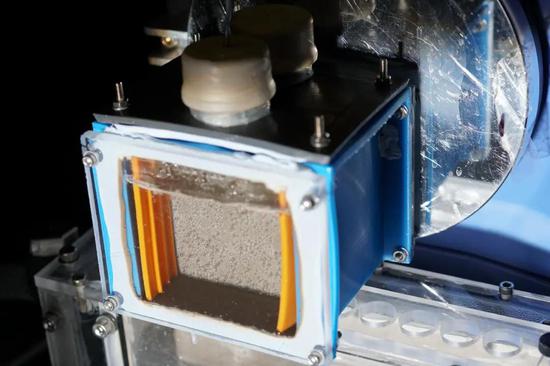Researchers have developed a set of equipment that can operate independently to convert sunlight, carbon dioxide and water into carbon-neutral fuels without any additional components or electricity. The device was developed by the Cambridge University team and took an important step towards the realization of artificial photosynthesis: this process imitates the ability of plants to convert sunlight into energy. The equipment is based on advanced "photosheet" technology, which can convert sunlight, carbon dioxide and water into oxygen and formic acid (a storable fuel that can be used directly or converted into hydrogen).

Image source: University of Cambridge
"Nature Energy" (Nature Energy) reported this result, demonstrating a new method of converting carbon dioxide into clean fuel. After the scale of this wireless device is expanded, it can be used in an energy "farm", similar to a solar farm, using sunlight and water to produce clean fuel.
Collecting solar energy to convert carbon dioxide into fuel is an effective way to reduce carbon dioxide emissions and gradually abandon fossil fuels. However, it is still challenging to produce clean fuels that do not contain unnecessary by-products.
"It has always been difficult to achieve highly selective artificial photosynthesis, which means that you can convert sunlight into the fuel you want as much as possible, instead of generating a lot of waste at the same time." said Dr. Qian Wang from the Cambridge Department of Chemistry .
"In addition, the storage of gaseous fuels and the separation of by-products are quite complicated. We want to figure out how to cleanly produce liquid fuels that are easy to store and transport." The senior author of the paper, Professor Erwin Reisner, added.
In 2019, researchers in the Reisner team developed a solar reactor based on an "artificial blade" design that uses sunlight, carbon dioxide and water to generate a fuel called syngas. The performance and behavior of this new technology are quite similar to "artificial leaves", but the working principle is different, and the product is formic acid.
Moreover, the artificial blade uses components from solar cells, but the new device does not need these components, and only relies on the photocatalyst embedded on the sheet to become the so-called photocatalytic sheet. These flakes are made of semiconductor powder and are easy to prepare in large quantities and are inexpensive.
In addition, this new technology is more robust, the clean fuel produced is easier to store, and has the potential to generate fuel products on a large scale. The size of the test unit is 20 square centimeters, but the researchers say it should be relatively simple to expand its size to a few square meters. At the same time, formic acid can accumulate in the solution and can be converted into different types of fuel by chemical means.
"We are amazed at the high selectivity of the technology, it produces almost no by-products." Wang said, "Sometimes things are different from expectations, but this time the effect is indeed better. It is really rare."
The carbon dioxide conversion cobalt-based catalyst is easy to realize and relatively stable. Although compared with artificial blades, the scale of this technology is easier to expand, but its efficiency still needs to be improved before it can be considered for commercial use. Researchers are experimenting with different types of catalysts to simultaneously enhance stability and performance.
The current results also depend on the cooperation of the team of Professor Kazunari Domen of the University of Tokyo, who is also a co-author of the study.
At present, researchers are further optimizing the system to improve performance. In addition, they are also exploring Other catalysts, using this equipment to obtain different solar fuels.
Reisner said: "We hope this technology will open the way for sustainable solar fuel production with practical value."
Source Cambridge University
Translation Akin
Review
FUXIBIO Ffp2 Mask manufactured by Careable biotechnology Co.,Ltd
- High filtration Efficiency
- In Chinese PPE Export Whitelist
- BSI CE NB2797 Certification
- Low Breathing Resistance: Flow Rate≥95 L/Min
- Real FFP2 Standard: Test agent in (≤3μm) DOP, Penetration≤6%
- ISO9001 Quality Management System Certificate
Careable Biotechnology Ffp2 Certified Respirator,Ffp2 Approved Respirator,Ffp2 Respirator,Ffp2 Certification 3D Mask
CAREABLE BIOTECHNOLOGY CO,. LTD , https://www.careablemask.com